Heuchera, commonly called coral bells, are easy to grow. They produce small flowers on stems that rise above their foliage, but they’re primarily grown for their lovely leaves. Flower colors include white, pink, light coral, and dark red. Coral Bells provide just about everything you could want in a container plant: they add a burst of color and variegation, they naturally mound, so they fill in a pot very nicely, and they are relatively low maintenance. Effortlessly add vibrant hues to a deck, entryway, or a hanging planter with Coral Bells. Like all plants, Coral Bells need a bit more care when grown in a container.
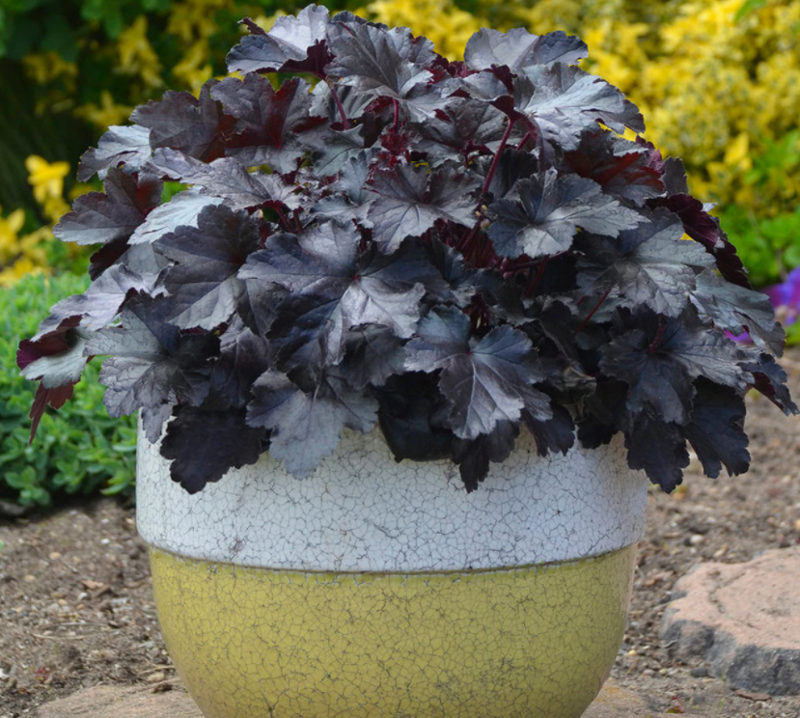
They’re available in a wide variety of foliage colors. Mix a few varieties to create a gorgeous container garden or combine them with other types of plants if you want more flowers in your container garden. Container gardens are a pretty way to spruce up your patio, balcony, deck, front steps, or to cover a bare spot in your garden.
Coral bells' medium to large leaves are heart-shaped or rounded. Many are variegated or have ruffled edges. Choose from varieties with lime, burgundy, chocolate brown, purple, or multiple shades of green.
Planting Coral Bells in Pots
The best time to plant Coral Bells in pots is during the spring. Once the temperatures are consistently warm and there is no longer a threat of frost, get your potted Coral Bells outside in a spot with partial shade so it can thrive. You can also plant in the summer and fall but the plant might require more water to help get established.
Use a container with a drainage hole at least 6 inches wider than the root ball to give the plants room to grow. Coral bells have shallow roots, so a tall container is not necessary. A single coral bells plant will grow to be about 15 inches wide, but some varieties can reach 24 inches across. Use a wider container if you want to add more than one coral bells or include other types of plants in your container garden design.
Coral bells produce flowers in late spring to early summer. It’s best to select a variety for its foliage rather than the flowers because the foliage will persist all season long. The foliage spikes range from 12 to 36 inches in height.
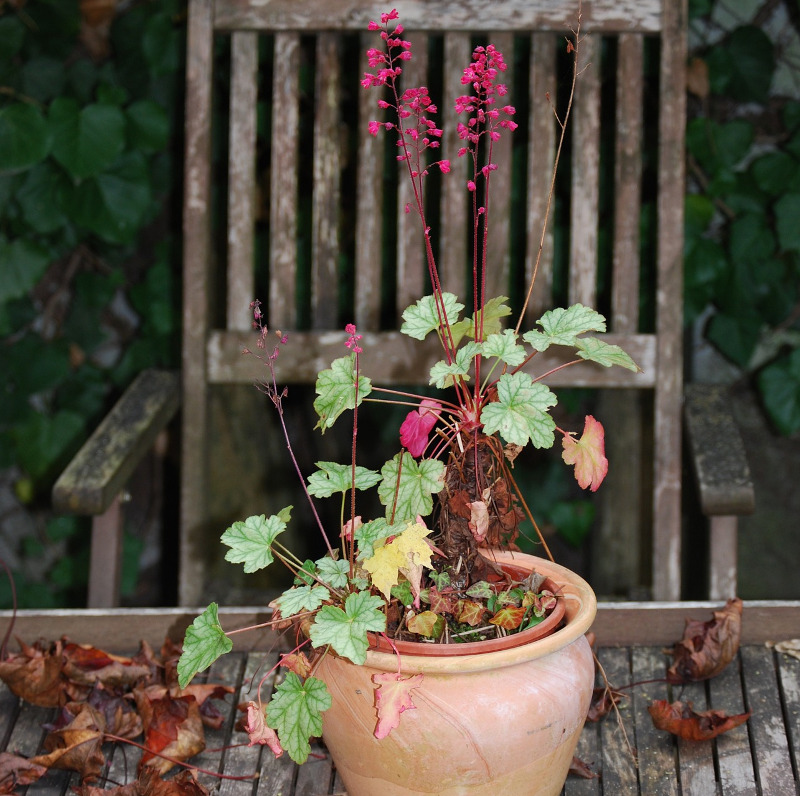
Coral bells prefer partial sun conditions but can tolerate full sun or shade conditions too. In general, Heuchera with lighter color leaves often prefer shadier conditions, and darker leaved ones can handle more sun. If the edges of the leaves turn brown with crunchy edges, move the container to a location where it will receive less sunshine.
Best Soil for Coral Bells in Pots
Rich soil with a high organic matter content is a good pick for Coral Bells. Mix in compost or manure to create good soil. Well-draining soil is necessary because Coral Bells like to dry out between watering. You may also use a good quality all-purpose potting soil for your container grown coral bells.
Add a half-inch layer of compost on top of the soil when initially potting them up. Be sure not to cover the crown of the plant with soil or compost.
Caring for Coral Bells in Pots
These plants will do best in a planter with drainage and require well-draining soil. Coral Bells can look lovely in a hanging basket. The plant does not naturally trail as much as plants typically grown in hanging baskets, but it does naturally mound so that it will create a very full look. Growing healthy coral bells plants in planters or other containers is fairly easy with just a few considerations. These plants make an excellent addition to any pot and are likely to thrive in it given the right steps are taken.
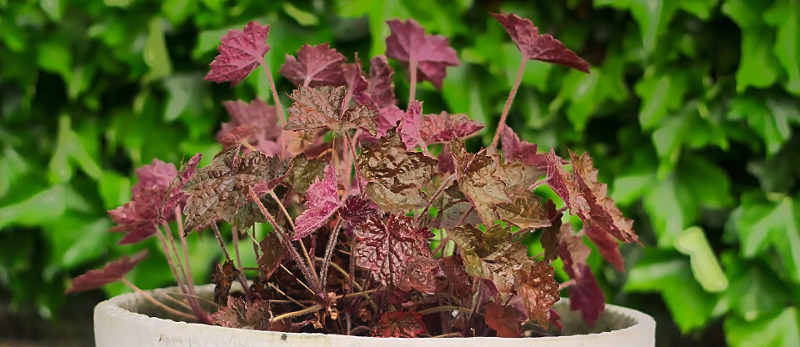
Watering Coral Bells in Pots
Plan to water Coral Bells in planters more often than plants in the ground, but otherwise, the care is the same. Coral bells prefer consistently moist but not waterlogged soil. Like most plants, they do best when receiving an inch of water per week combined from rainfall and hand watering. They may need more water if your container is unglazed, or they are in a sunny location where the pot may heat up and dry out the soil.
Water when the top few inches are dry to the touch and drench the soil until water runs through the drainage holes. Rain and periods of drought will impact the watering schedule, so pay attention and adjust as needed.
Fertilizing Coral Bells in Pots
Coral bells are not heavy feeders, so a slow-release fertilizer like compost is the best option to use. Add a half-strength solution of a water-soluble fertilizer every six weeks throughout the growing season.
However, plants grown in containers typically need to be fertilized more often because the nutrients in the soil are leached away due to more frequent watering. If you prefer, you can keep your Coral Bells looking their best by applying a water-soluble fertilizer every other week during the growing season. It is unnecessary to fertilize Coral Bells during the winter when the plant is dormant.
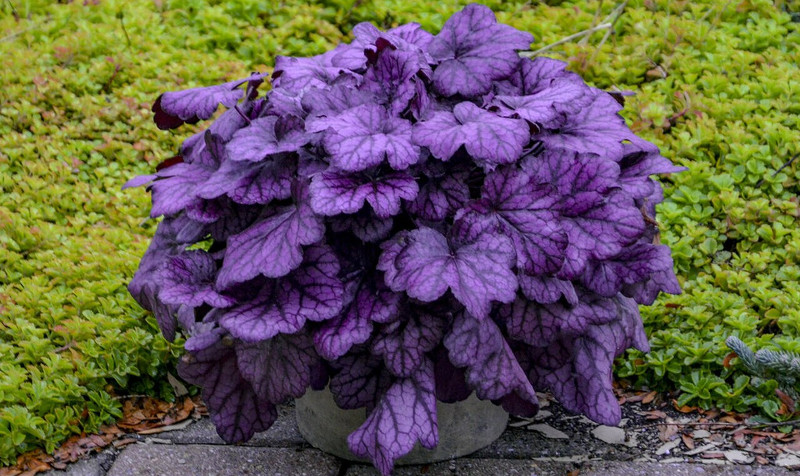
Winter Care for Coral Bells in Pots
Coral Bells are perennials, and the plant can survive the winter with help. The roots of a potted plant will not have enough protection and will be susceptible to cold damage if left outdoors. Transplanting the plant into the ground and applying mulch will insulate the roots and protect the plant during the winter.
If you live in an area where the temperature often falls below freezing, you can bring your container indoors for the winter to prevent it from cracking. Moving the pot indoors will also allow the plant to overwinter safely. The potted plant can be moved into a garage or shed and allowed to go dormant, or you can bring the potted Coral Bells into your home and grow it as a houseplant during the winter. Most coral bells are evergreen to they will need some light year-round for photosynthesis. Place your pots in an unheated garage or a shed with a window.
The plants will go dormant but will still need to be watered once a month to prevent them from drying out.
If the container is too large to move, wrap the pot with insulation in the fall to keep the temperature of the container more consistent and reduce the likelihood of it cracking
If you don’t have a garage or shed, dig a hole deep enough so the top of the container will be level with the soil and backfill the hole. Your potted coral bell will survive as if it was planted in your garden instead of in a container.
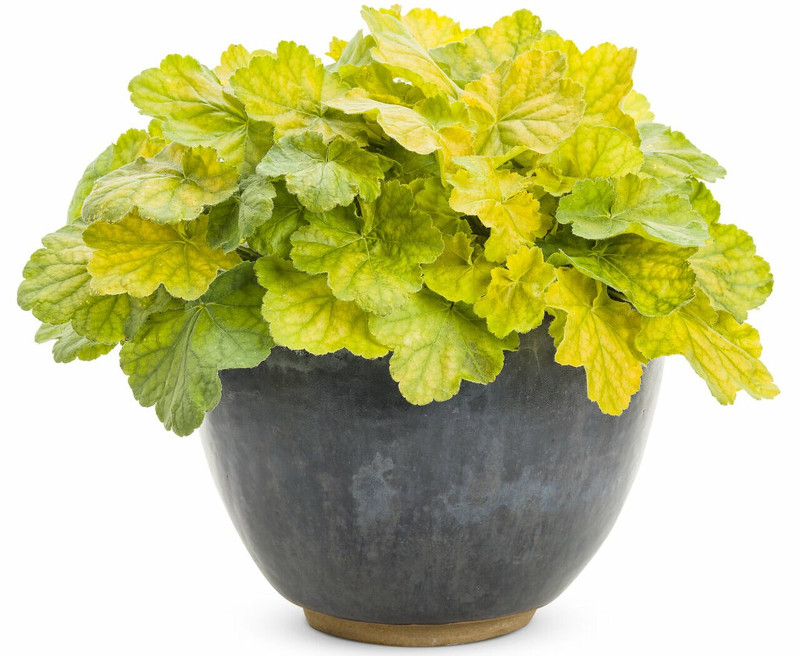
Can Coral Bells be Grown Indoors?
Coral Bells can be grown indoors as houseplants. Select a spot that receives medium to bright indirect light and water when the top few inches of the soil dry out. They prefer a site where the overnight temperature is between 45- and 60-degrees F. Keep the soil moist, but not wet. Coral Bells may go dormant, so water less often and wait until spring to feed. If the plant does go dormant, don’t worry if it doesn’t produce new leaves.
 |
Author Alison Cotsonas - Published 12-15-2021 |
